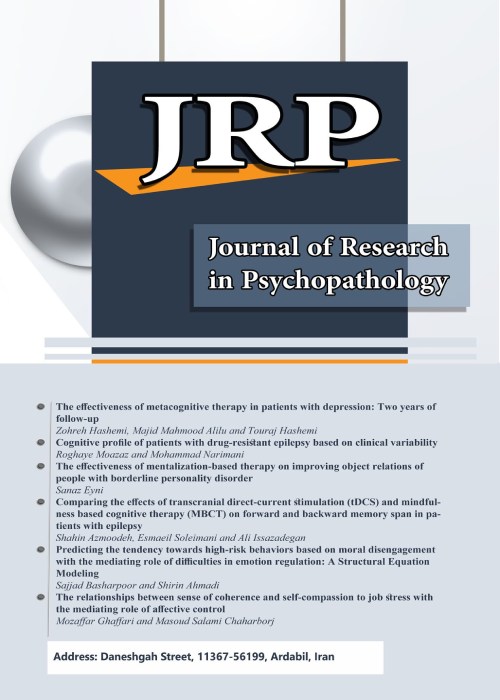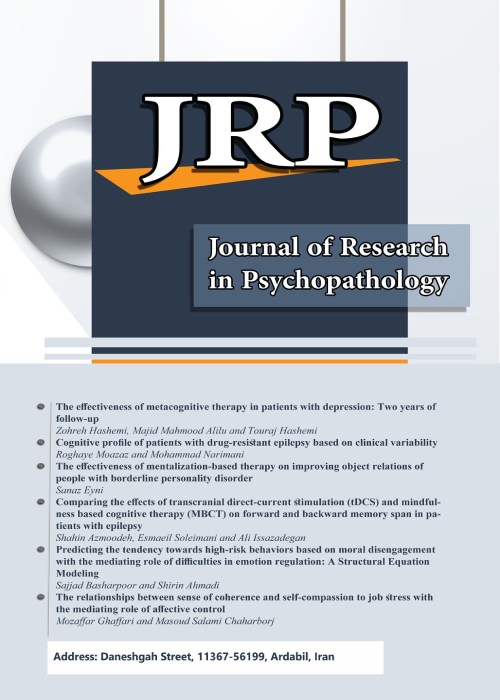فهرست مطالب

Journal of Research in Psychopathology
Volume:4 Issue: 11, Winter 2023
- تاریخ انتشار: 1401/12/01
- تعداد عناوین: 7
-
-
Pages 1-9The purpose of this study was to investigate the relationship between alexithymia, cognitive avoidance, and distress tolerance with obsessive-compulsive symptoms. A total of 150 students (105 girls and 45 boys) from the Ferdowsi University of Mashhad participated in this research. The participants were asked to complete the Persian version of the 20-Item Toronto Alexithymia Scale (TAS -20), the Cognitive Avoidance Scale (CAQ), the Distress Tolerance Questionnaire (DTS), Maudsley Obsessive-Compulsive Inventory (MOCI), and demographic data questionnaire. The data were analyzed using Pearson correlation and stepwise regression. The highest correlation relationships were between Obsessive-Compulsive with a total score of Alexithymia (r=0.43), the total score of Cognitive Avoidance Questionnaire (r=0.39), the total score of Distress Tolerance Scale (r=-0.43), Checking sub-scale of Obsessive-Compulsive Scale (r=0.71), Cleaning sub-scale of Obsessive-Compulsive Scale (r=0.75), Slowness sub-scale of Obsessive-Compulsive Scale (r=0.48) and Doubting sub-scale of Obsessive-Compulsive Scale (r=0.68). This study showed that the subscales of cleanliness, revision, hesitation, and slowness of obsessive-compulsive disorder and emotional dyslexia, distress tolerance, and cognitive avoidance have the greatest contribution in predicting obsessive-compulsive disorder. The results from the present study highlight the need to pay attention to these variables in the research and treatment of obsessive-compulsive disorder.Keywords: Obsessive-Compulsive Disorder, distress tolerance, cognitive avoidance, Alexithymia
-
Pages 10-16Sexual function is a multidimensional phenomenon affected by various biological-psychological and social factors. The present study aimed to investigate the mediating role of difficulty in emotion regulation in the association of sexual inhibition and sexual excitation with female sexual function. The participants of this study comprised 665 females serving in the administrative departments of Tehran and Tabriz universities, who were selected by convenience sampling. The Difficulties in Emotion Regulation Scale (2004), Sexual Excitation/Sexual Inhibition Inventory for Women (2006), and Female Sexual Functioning Index (1993) were employed to collect the data. In addition, SPSS (23 Ver.) and LISREL (8.8 Ver.) software packages were used for data analysis. The results of structural equation modeling indicated that sexual inhibition and sexual excitation, both directly and indirectly (emotion dysregulation), affect women’s sexual function. Evaluating the hypothetical model of the study employing the fitting indices revealed that the hypothetical model fits the measurement model (RFI = 0.98, NFI = 0.98, RMSEA = 0.032). Consistent with the dual control model, the results of this study showed that inhibition and sexual excitation affect the sexual function of women. In addition, the results showed that sexual inhibition and sexual excitation indirectly affect sexual function through difficulty in regulation emotion.Keywords: Sexual Inhibition, Sexual Excitation, emotion regulation, Sexual Function
-
Pages 17-22Separation anxiety disorder is one of the issues and problems that lead to academic failure and huge losses for the parents and society. This is a qualitative research on separation anxiety disorder in preschool children. The present research method was qualitative with a grounded theory approach based on Charmaz constructivist model. The population included mothers of children with separation anxiety disorder in Tehran in 2020, from whom 10 mothers were selected by homogeneous purposeful sampling until saturation. The semi-structured interview method was used to collect data and the data were analyzed with the MAXQDA software 2020 version. 370 primary codes, 4 themes including the position of strategic management application, the position of the determining father-affected mother, the effective position of the underlying factors, and the position of the child's sensitivity in infancy and childhood and showed a central category of early sensitivity to interactions and environment. It can be concluded that inadequate understanding of interactions and dysfunctional parenting strategies are effective in separation anxiety, and therefore to prevent this disorder, parental educational interventions and the involvement of fathers in parenting are recommended.Keywords: Separation anxiety, parents, Grounded Theory
-
Pages 23-32Tough and most intense job conditions make nurses unable to control negative emotion and meta-emotion and weaken their job performance. The present study was conducted with the aim of comparing the effectiveness of compassion therapy and meta-cognitive therapy on nurses’ meta-emotion levels. The research method was experimental with a pre-test, post-test and follow-up design. The sample included 60 nurses from hospitals in Tabriz in 2022, and they were randomly assigned to three groups of compassion therapy, meta-cognitive therapy and the control group. To collect the data, Mitmansgruber et al.’s (2009) meta-emotions scale was used. Then, the data were analyzed using the mixed analysis of variance model, Tukey's and Bonferroni's post hoc tests with the use of SPSS statistical software (version 22). The results showed that the effect of time factor on the amount of meta-emotion and its dimensions is significant. In other words, except compassion and interest, the amount of other dimensions of meta-emotions has decreased from pre-test to follow-up. Also, the interaction effect of time and group indicated that there was a significant difference between the compassion therapy and meta-cognitive therapy and control groups in the amount of anger (p < 0.000; F=20.98; Partial Eta2=0.424), shame (p < 0.000; F=17.47; Partial Eta2=0.380), anger control (p < 0.000; F=21.39; Partial Eta2=429), suppression (p < 0.000; F=8.93; Partial Eta2=0.329), compassion (p < 0.000; F=21.51; Partial Eta2=0.430) and interest (p < 0.000; F=36.79; Partial Eta2=0.564). But, no significant difference was observed between the effectiveness of these two interventions in reducing and increasing the amount of nurses’ meta-emotions. Considering the effectiveness of compassion and meta-cognitive therapys on the level of nurses’ meta-emotion, it seems that the application of compassion-based therapy and meta-cognitive therapy interventions will improve and moderate the level of meta-emotion in nurses.Keywords: Compassion, Meta-Cognitive, Therapy, Meta-Emotion, Nurse
-
Pages 33-39
The purpose of this study was to determine the effectiveness of Acceptance and commitment group therapy on perceived stress and marital distress of women with major depressive disorder seeking divorce in Rasht city in. The research method was quasi-experimental and pre-test and post-test with the control group. The statistical population of the present study included all women with major depressive disorder who applied for divorce referring to family counseling centers in Rasht city between to . By Sampling method available, people were selected and randomly assigned to experimental and control groups. Each group consisted of people. The instruments used were the Cohen Perceived Stress Scale and the Schneider Marital Disorder. Data were analyzed using SPSS- software with multivariate analysis of covariance. The results showed that there was a significant difference between the mean post-test scores of the experimental and control groups of perceived stress (Fand P <) and marital distress (F = and P <). The results showed Acceptance and commitment group therapy on perceived stress and marital turmoil in women with major depressive disorder seeking divorce was significant. It can be concluded that the interventions of this study are effective in reducing stress and marital distress in women with underlying officer disorder on the verge of divorce. The use of this treatment method in proceedings mental health measures is recommended for incompatible couples. It can also be used in family counseling and divorce prevention centers
Keywords: Acceptance, commitment based therapy, perceived stress, Marital Distress, divorce -
The relationship between the emotional nature, adult attachment and aggression in depressed patientsPages 40-46
In this study, the relationship between emotional nature and adult attachment and aggression in depressed patients was investigated. The present study was a descriptive correlational study. The statistical population of this study includes all depressed patients aged 18-40 years in Ardabil in 2015. The sample of this study included 75 depressed patients who were selected by available methods. The Emotional Nature Scale, the Collins-Reid Attachment Scale, and the Williams Aggression Questionnaire were used to collect data. Pearson correlation method and multivariate regression analysis were used to analyze the data. Data analysis indicated that there is a significant positive relationship between emotional nature with adult attachment and aggression in depressed patients (P <0.01). Based on the results of multivariate regression, the dimensions of emotional nature were able to predict with adult attachment and aggression in depressed patients (P <0.01). This result has important implications for promoting mental health in patients with depression.
Keywords: Emotional nature, Attachment, Aggression, Depressed Patients -
Pages 47-53
Students are one of the most important and vital assets in any country, yet nowadays they are having an increasingly stronger tendency to addiction. The aim of this study was to develop a model of addiction tendency based on helicopter parenting and personal intelligence with the mediating variable of mental toughness. The research method was descriptive-correlational using structural equation modeling. The statistical population of the study consisted of students at Bonab and Maragheh universities of medical sciences in 2021. 285 participants were selected through the convenience sampling method. The research instruments included the Luebbe et al.’s (2018) Helicopter Parenting Questionnaire, Mayer et al.’s (2013) Personal Intelligence Questionnaire, Clough, Earle, and Sewell’s (2002) Mental Toughness Questionnaire, and Weed and Butcher’s (1992) Addiction Tendency Questionnaire. The structural equation modeling method and the SPSS and AMOS software version 24 were used for data analysis. The results showed that the helicopter parenting style and mental toughness both play a role in explaining the model of students' passive tendency to addiction. Finally, 57% of the variance of passive tendency to addiction and 7% of the variance of mental toughness were explained by model variables. According to the results, it is suggested that helicopter parenting, mental toughness, and personal intelligence be considered in interventions related to reducing the tendency to addiction.
Keywords: Tendency, Drug Addiction, Helicopter Parenting, Mental toughness, Personal intelligence


